display Citroen C4 PICASSO 2016 2.G Owner's Guide
[x] Cancel search | Manufacturer: CITROEN, Model Year: 2016, Model line: C4 PICASSO, Model: Citroen C4 PICASSO 2016 2.GPages: 527, PDF Size: 13.72 MB
Page 115 of 527
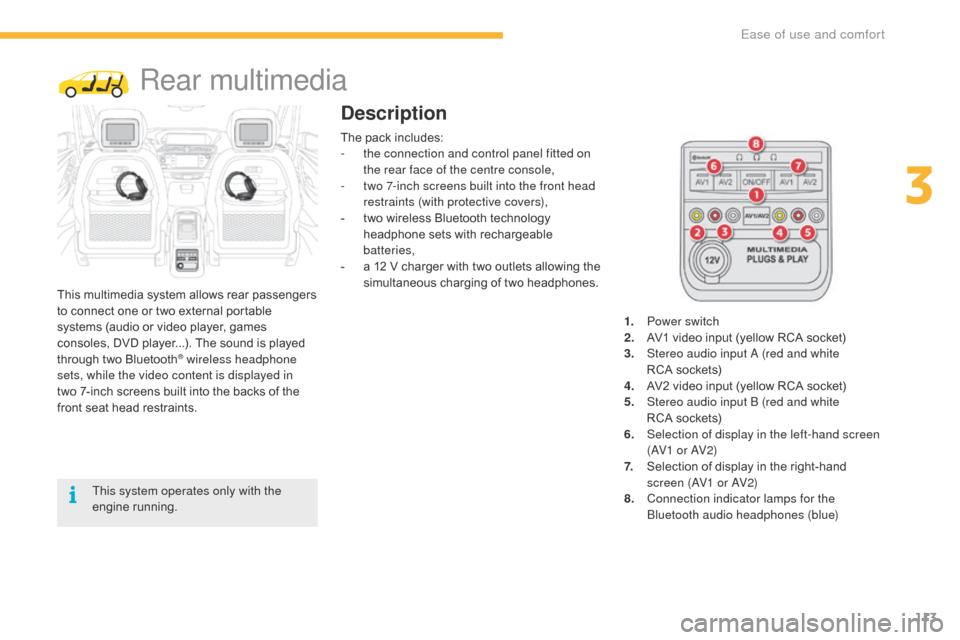
113
C4-Picasso-II_en_Chap03_ergonomie-confort_ed01-2016
Rear multimedia
This multimedia system allows rear passengers to connect one or two external portable
s
ystems (audio or video player, games
c
onsoles, DVD player...). The sound is played
t
hrough two Bluetooth
® wireless headphone
sets, while the video content is displayed in
two 7-inch
screens
built into the backs of the
f
ront
seat
head
restraints.
Description
This system operates only with the
engine r unning. The
pack includes:
-
t
he connection and control panel fitted on
the rear face of the centre console,
-
t
wo 7-inch screens built into the front head
restraints (with protective covers),
-
t
wo wireless Bluetooth technology
h
eadphone sets with rechargeable
b
atteries,
-
a
12 V charger with two outlets allowing the
s
imultaneous charging of two headphones.
1.
P
ower switch
2.
A
V1 video input (yellow RCA socket)
3.
S
tereo audio input A (red and white
RCA sockets)
4.
A
V2 video input (yellow RCA socket)
5.
S
tereo audio input B (red and white
RCA sockets)
6.
S
election of display in the left-hand screen
(AV1 o r AV2)
7.
S
election of display in the right-hand s
creen (AV1 or AV2)
8. C onnection indicator lamps for the
Bluetooth audio headphones (blue)
3
Ease of use and comfort
Page 116 of 527

114
C4-Picasso-II_en_Chap03_ergonomie-confort_ed01-2016
1. Screen power switch
2. Display a djustment bu ttons
Each headphone set has a switch,
a connection indicator lamp (blue)
and
a channel selector (A or B).F
W ith the engine running, connect your
p
ortable system to the RCA connectors
(e.g.
with AV1 on the left).
F
P
ress the switch on the control panel, the
indicator lamp comes on and
the
AV1 indicator lamps come on.
F
M
ake a long press on the switch, its
i
ndicator lamp flashes in blue.
F
M
ake a long press on the control panel
s
witch, the pairing with the headphone set
i
s complete when the blue indicator lamps
on the headphones and on the system are
on
continuously.
F
R
epeat the operation for the other
headphone
se
t.
F
P
ress the screen switch if you have a video
source.
F
S
tart playing your portable system.
Operation
The Multimedia system allows the
connection of a third Bluetooth
headphone set, not supplied.
If your seat is in the table position,
position
a cover to avoid damaging the
sc
reen.
These covers also conceal each
screen.
F
I
t is possible at any time to modify the
source for the video display (using button 6
or 7 on the control panel: the indicator lamp
f
or the source selected comes on) as well
as the audio channel (using the selector on
t
he
hea
dphones).
Ease of use and comfort
Page 129 of 527

127
C4-Picasso-II_en_Chap04_conduite_ed01-2016
Starting-switching off the engine with Keyless Entry and Starting
F Place the gear selector lever at P or N for
vehicles with an automatic gearbox, or
n
eutral with a manual gearbox.
F
W
ith the electronic key inside the vehicle,
p
ress the brake pedal for vehicles with an
a
utomatic gearbox, or fully declutch for
v
ehicles with a manual gearbox.
Diesel vehicles
In temperatures below zero the
engine will not start until the
p
reheater warning lamp has
g
one off.
Starting the engine
The presence of the "Keyless Entry and
Starting" electronic key in the recognition zone
i
s
e
ssential.
It
is not necessary to place the electronic key in
t
he back-up reader.
If
the electronic key is not detected,
a
message is displayed. Move the
e
lectronic key into the recognition zone
s
o that the engine can be started.
In the event of a problem, see "Key not
detected
/ Back-up starting".
F
B riefly press the "
S TA R T/
STOP "
button while maintaining
p
ressure on the pedal until the
engine
s
tarts.
If one of the starting conditions is not met, a reminder message appears in the i
nstrument panel screen.
In some circumstances, it is necessary
to
turn the steering wheel slightly while
p
ressing the "START/STOP " button
to
assist unlocking of the steering; a
m
essage warns you when this is needed.
As a safety measure, never leave the
vehicle while the engine is running.
The
steering
column
unlocks
and
the
engine
s
tarts
more
or
less
instantly.
See
the
advice
below
for
Diesel
versions. If
this warning lamp comes on after
p
ressing "START/STOP ", you should
hold
the brake or clutch pedal down
u
ntil the warning lamp goes off and do
n
ot press the " START/STOP " button
again
before the engine starts.
4
Driving
Page 134 of 527

132
C4-Picasso-II_en_Chap04_conduite_ed01-2016
Label on door panel
Before leaving the vehicle, check that the parking brake is applied: the
in
dicator lamps in the instrument panel
and
the control lever must be on fixed,
n
ot
f
lashing.
If
the parking brake is not applied, there
i
s an audible signal and a message is
d
isplayed on opening the driver's door.
Never leave a child alone inside the
vehicle
with the ignition on, as they
c
ould release the parking brake.When
towing, parking on a steep slope, o
r if your vehicle is heavily laden,
turn
the wheels towards the kerb and
e
ngage a gear (with a manual gearbox)
o
r place the gear selector at position P
with
an automatic gearbox.
For
towing, your vehicle is approved for
p
arking on slopes of up to 12%.
Manual operation
Application of the parking brake is confirmed by illumination of
the
brake indicator lamp and
t
he P indicator lamp in the control
lever, accompanied by the display of
the
m
essage
"
Parking
b
rake
a
pplied".
Manual release
With the ignition on or the engine running, to release the parking brake:
F
p
ress the brake pedal,
F
w
hile maintaining pressure on the brake
p
edal, briefly push the control lever.
The
complete release of the parking brake
i
s confirmed by the brake indicator lamp and
t
he P indicator lamp in the control lever going
o
ff,
a
ccompanied
b
y
t
he
d
isplay
o
f
t
he
m
essage
"
Parking brake released".
If you push the control lever without
pressing
the brake pedal, the parking
b
rake will not be released and a
m
essage is displayed.
Manual application
With the vehicle stationary: briefly pull the control lever.
Confirmation of the command is signalled by flashing of the indicator lamp in the control
l
eve r.
Driving
Page 135 of 527
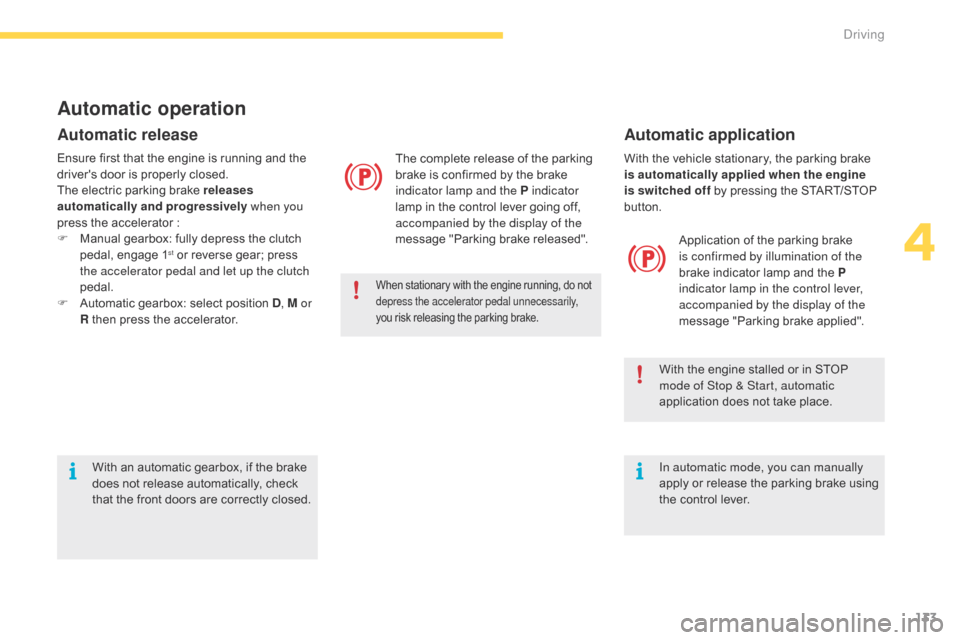
133
C4-Picasso-II_en_Chap04_conduite_ed01-2016
With the vehicle stationary, the parking brake is automatically applied when the engine
is switched off
by pressing the START/STOP
b
utton. Application
of the parking brake
i
s confirmed by illumination of the
brake
indicator lamp and the P
indicator lamp in the control lever,
accompanied by the display of the
message
"Parking brake applied".
With
the engine stalled or in STOP
m
ode of Stop & Start, automatic
application
does not take place.
In automatic mode, you can manually
apply
o
r
r
elease
t
he
p
arking
b
rake
u
sing
t
he control lever.
Automatic operation
Automatic release
The complete release of the parking brake is confirmed by the brake
i
ndicator lamp and the P indicator
lamp
in the control lever going off,
a
ccompanied by the display of the
message
"Parking brake released".
When stationary with the engine running, do not depress the accelerator pedal unnecessarily,
you
risk releasing the parking brake.
Ensure first that the engine is running and the driver's door is properly closed.
The
electric parking brake releases
automatically and progressively when you
press
the accelerator :
F
M
anual gearbox: fully depress the clutch
p
edal, engage 1
st or reverse gear; press t
he accelerator pedal and let up the clutch
pedal.
F
A
utomatic
gearbox: select position D, M or
R
then
press
the
accelerator.
Automatic application
With an automatic gearbox, if the brake d oes not release automatically, check
t
hat the front doors are correctly closed.
4
Driving
Page 136 of 527
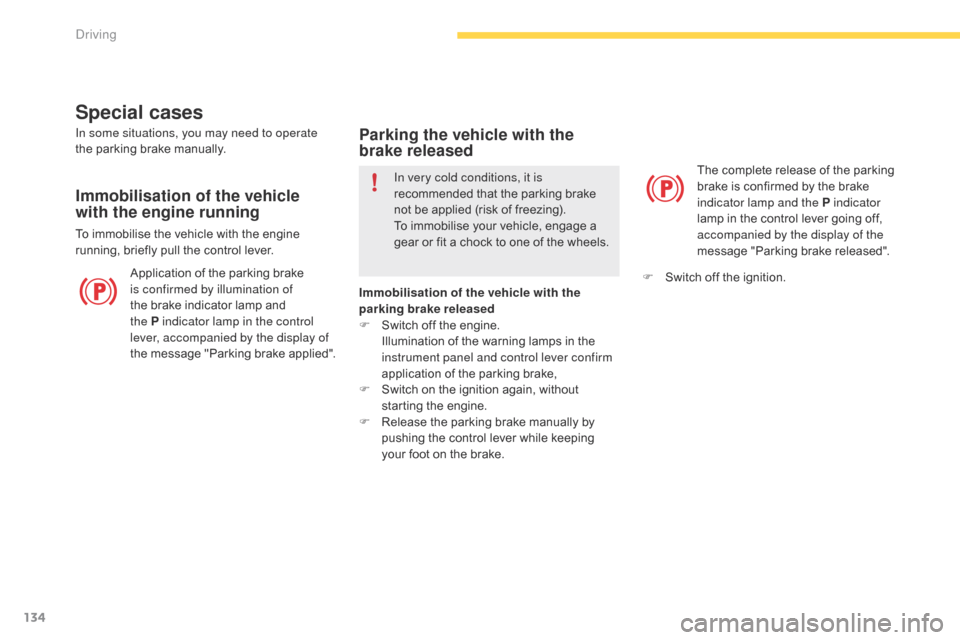
134
C4-Picasso-II_en_Chap04_conduite_ed01-2016
Special cases
Application of the parking brake is confirmed by illumination of
the
brake indicator lamp and
t
he P indicator lamp in the control
lever, accompanied by the display of
the
m
essage
"
Parking
b
rake
a
pplied". The
complete release of the parking
b
rake is confirmed by the brake
i
ndicator lamp and the P indicator
lamp in the control lever going off,
a
ccompanied by the display of the
message "Parking brake released".
In some situations, you may need to operate
the
parking brake manually.
Immobilisation of the vehicle
with the engine running
To immobilise the vehicle with the engine r
unning, briefly pull the control lever.
Parking the vehicle with the
brake released
In very cold conditions, it is
recommended that the parking brake
n
ot be applied (risk of freezing).
To
immobilise your vehicle, engage a
g
ear or fit a chock to one of the wheels.
Immobilisation of the vehicle with the
parking brake released
F
S
witch off the engine.
I
llumination of the warning lamps in the
i
nstrument panel and control lever confirm
application
of the parking brake,
F
S
witch on the ignition again, without
s
tarting the engine.
F
R
elease the parking brake manually by
p
ushing the control lever while keeping
y
our foot on the brake. F
S
witch off the ignition.
Driving
Page 138 of 527
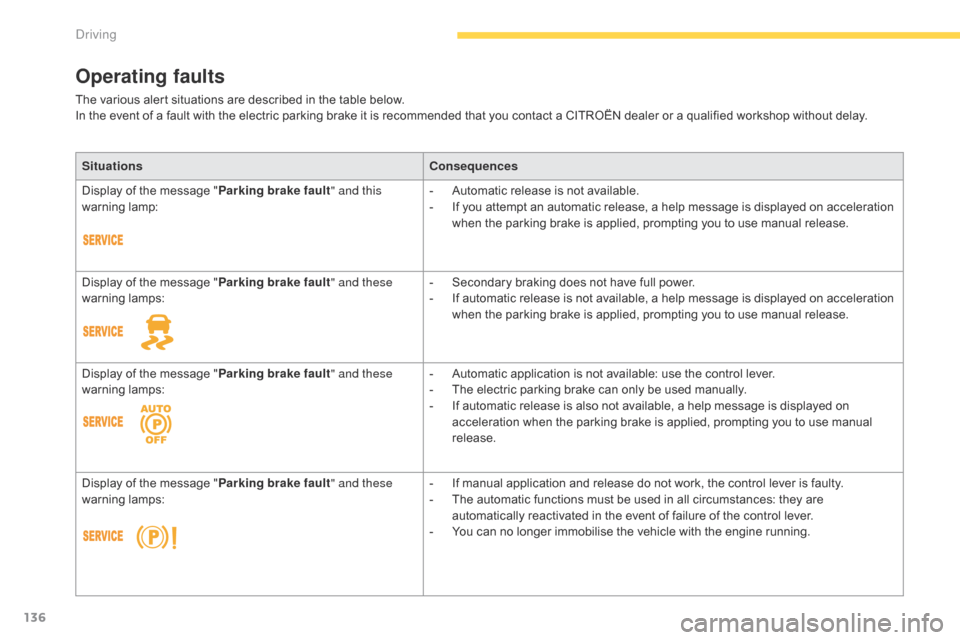
136
C4-Picasso-II_en_Chap04_conduite_ed01-2016
Operating faults
The various alert situations are described in the table below.
I n the event of a fault with the electric parking brake it is recommended that you contact a CITROËN dealer or a qualified workshop without delay.
Situations Consequences
Display
of the message "Parking brake fault " and this
warning
lam
p: -
A
utomatic release is not available.
-
I
f you attempt an automatic release, a help message is displayed on acceleration
w
hen the parking brake is applied, prompting you to use manual release.
Display
of the message "Parking brake fault " and these
warning
lam
ps: -
S
econdary braking does not have full power.
-
I
f automatic release is not available, a help message is displayed on acceleration
w
hen the parking brake is applied, prompting you to use manual release.
Display
of the message "Parking brake fault " and these
warning
lam
ps: -
A
utomatic application is not available: use the control lever.
-
T
he electric parking brake can only be used manually.
-
I
f automatic release is also not available, a help message is displayed on
a
cceleration when the parking brake is applied, prompting you to use manual
r
elease.
Display
of the message "Parking brake fault " and these
warning
lam
ps: -
I
f manual application and release do not work, the control lever is faulty.
-
T
he automatic functions must be used in all circumstances: they are
a
utomatically reactivated in the event of failure of the control lever.
-
Y
ou can no longer immobilise the vehicle with the engine running.
Driving
Page 139 of 527

137
C4-Picasso-II_en_Chap04_conduite_ed01-2016
SituationsConsequences
Display of the message "Parking brake fault " and these
warning
lam
ps: The
parking brake is faulty, the manual and automatic functions may not operate.
When stationary ,
to immobilise your vehicle:
-
P
ull and hold the control lever for about 7 to 15 seconds, until the warning lamp
c
omes on in the instrument panel.
If
this procedure does not work, you should make your vehicle safe:
-
P
ark on a level sur face.
-
E
ngage a gear with a manual gearbox, or place the gear selector at position P
with
an automatic gearbox.
-
I
f possible, fit a wheel chock.
Call
on a CITROËN dealer or a qualified workshop.
Display
of the message "Parking brake fault " and these
warning
lam
ps: -
T
he parking brake does not have its full per formance to securely hold the vehicle
i
n all situations.
You
should make your vehicle safe:
-
P
ark on a level sur face.
-
E
ngage a gear with a manual gearbox, or place the gear selector at position P
with
an automatic gearbox.
-
I
f possible, fit a wheel chock.
Call
on a CITROËN dealer or a qualified workshop.
The
flashing of the P warning lamps on starting the vehicle indicates that the parking
b
rake is not correctly applied.
As
soon as possible, stop the vehicle and try to completely release the parking brake,
u
sing the control lever, with your foot on the brake pedal.
Display
of the message "Battery fault "
and this warning lamp:-
T
he state of charge of the battery is very low and requires immobilisation of the
v
ehicle in a safe place: engage a gear with a manual gearbox or fit a chock to
o
ne of the wheels.
-
O
nce the battery is completely discharged, the controls do not operate: to
r
elease the parking brake, call on a CITROËN dealer or a qualified workshop.
4
Driving
Page 143 of 527
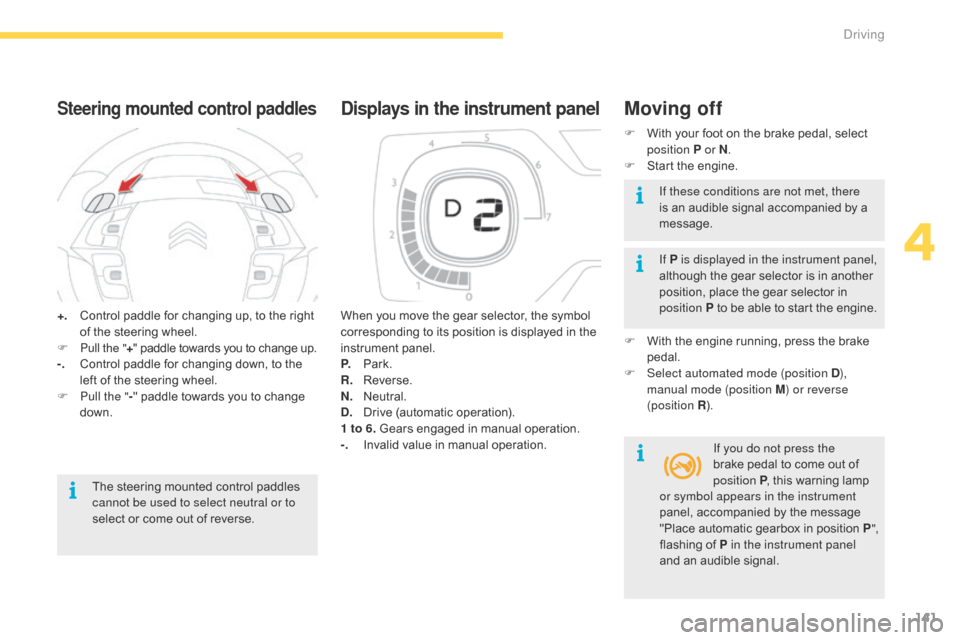
141
C4-Picasso-II_en_Chap04_conduite_ed01-2016
+. Control paddle for changing up, to the right o
f the steering wheel.
F
P
ull the " +"
paddle towards you to change up.
-.
C
ontrol paddle for changing down, to the
l
eft of the steering wheel.
F
P
ull the " -"
paddle towards you to change
d
own.
Steering mounted control paddles
The steering mounted control paddles cannot be used to select neutral or to
select
or come out of reverse. When
you move the gear selector, the symbol
c
orresponding to its position is displayed in the
in
strument
pan
el.
P.
Pa
rk.
R.
R
everse.
N.
N
eutral.
D.
D
rive
(
automatic
ope
ration).
1 to 6. Gears engaged in manual operation.
-.
I
nvalid value in manual operation.
Displays in the instrument panelMoving off
F With
your foot on the brake pedal, select p
osition P or N .
F
S
tart the engine.
If P is displayed in the instrument panel,
although
the gear selector is in another
p
osition, place the gear selector in
p
osition P to be able to start the engine.
F
W
ith the engine running, press the brake
ped
al.
F
Sel
ect automated mode (position D ),
manual mode (position M ) or reverse
(position R ).
If you do not press the
brake
pedal to come out of
p
osition P,
this warning lamp
I
f these conditions are not met, there
is
an audible signal accompanied by a
m
essage.
or symbol appears in the instrument
panel,
accompanied by the message
"
Place automatic gearbox in position P",
flashing
of P in the instrument panel
and
an audible signal.
4
Driving
Page 144 of 527
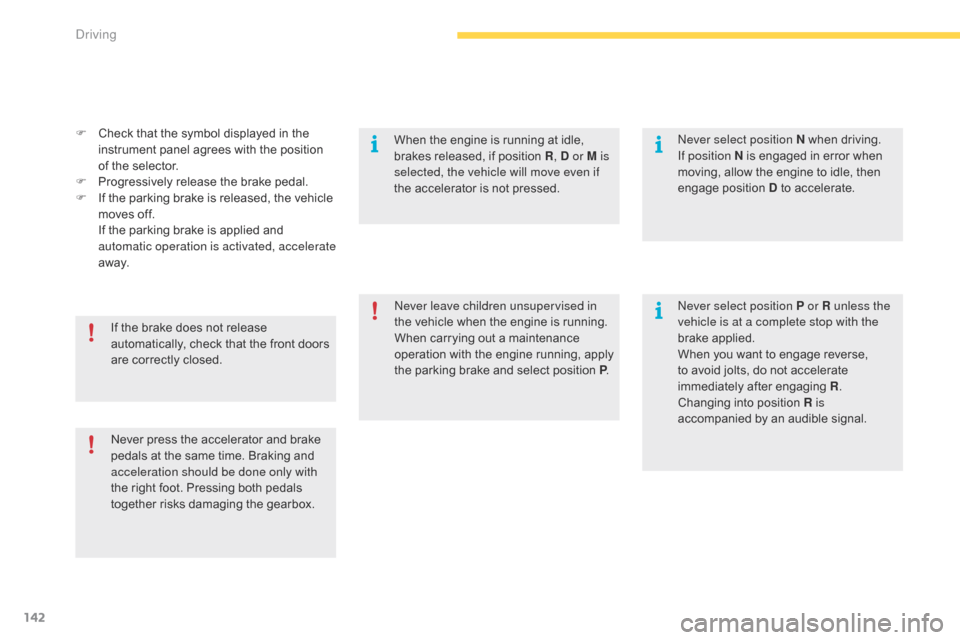
142
C4-Picasso-II_en_Chap04_conduite_ed01-2016
F Check that the symbol displayed in the i
nstrument panel agrees with the position
o
f the selector.
F
P
rogressively release the brake pedal.
F
I
f the parking brake is released, the vehicle
m
oves off.
I
f the parking brake is applied and
a
utomatic operation is activated, accelerate
away.
Never
press the accelerator and brake
p
edals at the same time. Braking and
a
cceleration should be done only with
the
right foot. Pressing both pedals
t
ogether risks damaging the gearbox.
If
the brake does not release
a
utomatically, check that the front doors
a
re correctly closed. Never leave children unsupervised in
the
vehicle when the engine is running.
When
carrying out a maintenance
o
peration with the engine running,
a
pply
t
he parking brake and select position P. Never select position P or R unless the
vehicle is at a complete stop with the
brake
a
pplied.
When
you want to engage reverse,
t
o avoid jolts, do not accelerate
i
mmediately after engaging R.
Changing
in
to
p
osition
R
is
accompanied
by an audible signal.
Never select position N
when driving.
I
f position N is engaged in error when
m
oving, allow the engine to idle, then
e
ngage position D to accelerate.
When
the engine is running at idle,
b
rakes released, if position R, D or M is
selected, the vehicle will move even if
the
accelerator is not pressed.
Driving